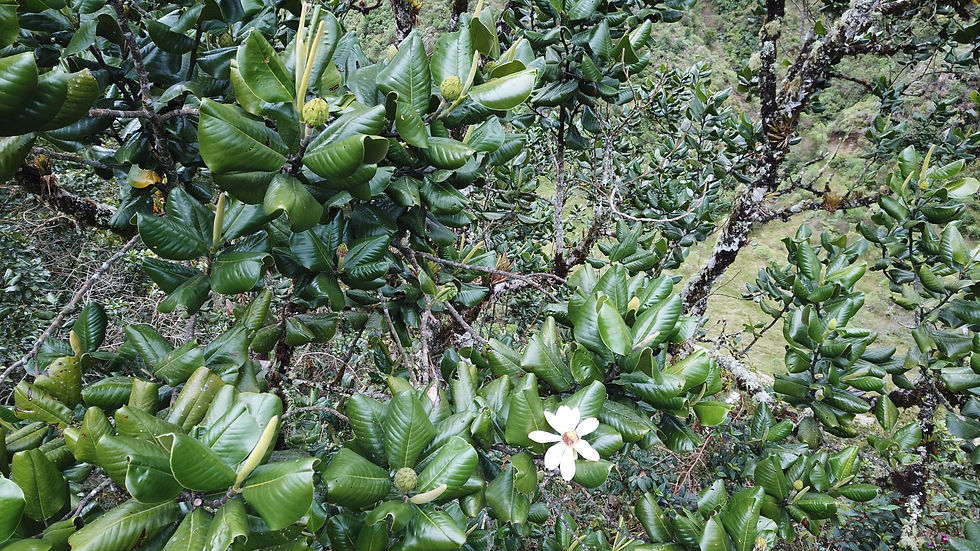November 2021 - MPNR’s Olinguito Forest: Germplasm Bank For Endangered Magnolia
- Luis A Mazariegos

- Nov 15, 2021
- 4 min read
Updated: Mar 14, 2022

On a recent visit to the Olinguito Forest at the Mesenia - Paramillo Nature Reserve (MPNR), botanist and Magnolia expert, Alvaro Cogollo, was astonished and surprised to find two Critically Endangered (CR) and one Endangered (EN) species of Magnolia: Magnolia jardinensis, M. espinalii, and M. yarumalensis, respectively.
Alvaro claims to never have seen M. jardinensis trees of the size he saw at the Olinguito forest. The literature reports trees 30m in height and these trees reach some 70 meters into the canopy. Fortunately, these trees were saved from being logged by acquiring the 130-hectare plot with support from Saving Nature in 2015. About a dozen mature trees and over 20 young trees were located on a five our walk from 2000 to 2600-meter elevation. In 2011, Corantioquia reported only 9 mature trees of this species in all of its jurisdiction.
Left to right, park ranger Ubiel Rendon, Executive Director Luis Mazariegos and Botanist and Magnolia expert Alvaro Cogollo, under a CR M. jardinensis reaching over 70 meters in height.

Also, this is the first time Alvaro Cogollo finds the CR M. espinalii in a protected area. Four young individuals were seen, measured, marked and georeferenced on the main trail. A more thorough search will be performed to find the mature tree from which these seeds were dispersed and from which other seedlings can be recovered.
Alvaro commented he found a mature individual of M. espinalii near the city of Medellin and he saved it from being cut down by a road building project. Yet, the tree has not produced any seeds through the years as the flowers are not pollinated. Insects appear to play a key role in the pollination of Magnolia and due to habitat destruction, local extinction of such pollinators have such somber outcome. According to Corantioquia, as of 2011 there were only 24 known surviving trees.
Park ranger Ubiel Rendon marking a young Magnolia espinalii found on the main trail to the cabin at the Olinguito forest.
The most abundant species at the Olinguito forest was M. yarumalensis and some 50 trees were observed during our hike. It is calculated that over 200 mature trees of this species are found here. In contrast, Corantioquia has only identified 30 mature trees of this species. At this time of the year, this species is flowering and producing fruiting bodies. Unfortunately, we found many aborted flower buds and fruits around trees. It is worth noting that during 2021, excess rains have been predominant and no dry season has occurred, causing trees to undergo biotic stress.

Aborted flowers and fruiting bodies of Magnolia yarumalensis were found on the ground around trees during our visit.
There is an urgent need to study the phenology and growth requirements of the endangered Magnolia trees in situ. It has been reported that most mature trees have fruits all year round. However, very few of them reach maturity due to mass abortion of flowers and fruits at different stages of development. The dispersal of seeds is done by birds and small mammals, but little is known about the insects that pollinate Magnolia. Additionally, the soil microbiome could play an important role and needs to be studied.

Using a drone to reach the canopy of an M. yarumalensis, we were able to see flowers and fruiting bodies at various developmental stages. This tool provides a time saving and easier means to reach the treetops, eliminating the associated risks of someone climbing.
Undoubtedly, the Olinguito forest is home to the oldest trees in all of the southwest region of Antioquia and significantly increase the number of mature trees of endangered Magnolia. Alvaro Cogollo sees this forest as a germplasm bank for endangered species as well as for other fine woods. He has proposed setting up a local tree nursery to grow native species that can be used to restore pasturelands in the area, which is in line with the tree planting program Bioconservancy is carrying out. Seven months ago, MPNR's park rangers collected 216 seedlings of Magnolia at the Olinguito forest of which 208 survived. The majority of them, 203, were M. yarumalensis and the other five were M. jardinensis. These trees are currently being cared for at one of our nurseries and will be planted by year's end. We have an established procedure to collect and transfer as many seedlings as possible in order to reestablish the species in areas where they once flourished.
Locally M. jardinensis is known as “Gallinazo Blanco" or "Centello”, M. espinallii as “Hojarasco” and M. yarumalensis as “Gallinazo Morado”. Additional to the endangered Magnolia species, the Olinguito forest holds an impressive number of other important fine wood trees which include Podocarpus macrostachys (Chaquiro), Calophyllum Brasiliense (Barcino), Quercus humboldtii (Roble de Tierra Fría), Cedrella montana (Cedro de Tierra Fría), Juglans neotropica (Cedro Negro), Aniba coto (Laurel Comino), Aniba perutilis (Comino Crespo), Nectandra acutifolia (Laurel), Nectandra laurel (Laurel Amarillo) and Citharexylum subflavescens (Quimulá).






Comments